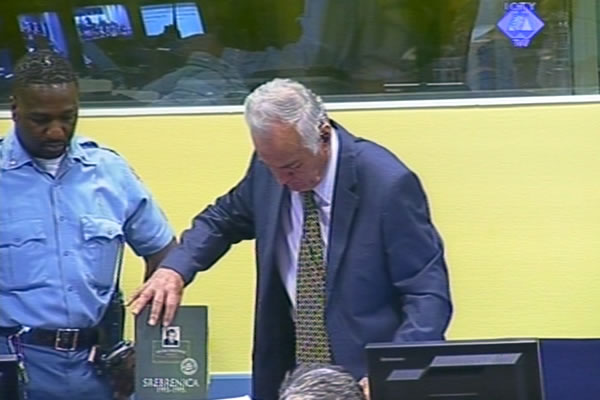Home
MILITARY OBSERVERS OR ‘BUNKER OBSERVERS’
Referring to a report made by the Dutch Institute for War Documentation, Ratko Mladic’s defense tried to contest the credibility of UN military observer Joseph Kingori. According to the report, the Kenyan colonel and his colleagues observed the interior of bunkers where they were hiding, rather than the situation in Srebrenica and Potocari in July 1995
 Ratko Mladic in the courtroom
Ratko Mladic in the courtroom ‘Have no fear...the people will all get on board...make sure you don’t lose any children’, Ratko Mladic said to the refugees gathered in Potocari on 12 July 1995. According to the Kenyan colonel Joseph Kingori, Mladic ‘didn’t mean what he said’. Today, after the footage of that conversation was played again, the former commander of the Bosnian Serb army commented loudly, ‘yes, that’s right’, nodding his head in approval of what he said in July 1995.
Defense counsel Miodrag Stojanovic played the recording in a bid to contest the claims made by the Kenyan colonel that on 12 July 1995 he talked to Mladic about the men detained in the White House in ‘poor conditions’. The men had previously been separated from the women and children in Potocari. They were then removed from the White house, put on the buses and executed. The defense claimed that the conversation ‘never took place’ and referred to a statement made by a member of the special police unit who purportedly served as Mladic’s interpreter that day.
In a bid to contest the credibility of the witness, the defense lawyer quoted from a report of the Dutch Institute for War Documentation (Nederlands instituut voor oorlogsdocumentatie-NIOD) about the events in Srebrenica, which states that the Dutch Battalion soldiers called the UN military observers “UNBO – United Nations Bunker Observers’ because they never left their bunkers for safety reasons. According to the report, the UN military observers followed the situation in the field through interpreters they sent to Srebrenica.
The Kenyan colonel reacted strongly to that claim, insisting it was ‘wrong for several reasons’. As Kingori said, in Srebrenica they observed the shelling and they described it in their reports before they went to Potocari on 9 July 1995. ‘We didn’t meet with Mladic in a bunker, we wouldn’t have been able to hear the rockets, shells, the artillery in a bunker’, the witness replied.
After they withdrew to the Dutch Battalion base, the two military observers sent interpreter Emir Suljagic to Srebrenica and kept in touch with him over the radio. Based on Suljagic’s reports, the observers wrote their own reports and sent them to the HQ in Zagreb. According to the defense, they couldn’t vouch for the information contained in those reports because they didn’t actually see the events they reported to their superiors. Kingori didn’t agree with this argument, noting, ‘we could see for ourselves what was fired on Srebrenica’.
At the beginning of the hearing, Mladic showed a book in a green cover to the visitors in the public gallery. Mladic kept the book, entitled Srebrenica 1993 to 1995: A War Diary of Hamed Salihovic, in front of him for a while. When the examination turned to the topic of the shelling of Srebrenica, Mladic gave the book to his defense counsel and indicated to him the parts he had marked in red.
The trial of Ratko Mladic for double genocide and other crimes in Bosnia and Herzegovina continued with the evidence of a protected witness testifying under the pseudonym RM 255. In July 1995, the witness survived the execution at the Branjevo farm near Zvornik.
Linked Reports
- Case : Mladic
- 2012-07-18 KINGORI: IN SREBRENICA MLADIC DIDN’T MEAN WHAT HE SAID
- 2012-07-17 DEPORTATION IS ‘FORCIBLE EVACUATION’
- 2012-07-16 MLADIC SHOWS HE IS IN GOOD SHAPE
- 2012-07-20 MLADIC MAKES OFFENSIVE REMARKS ABOUT SREBRENICA VICTIMS
- 2012-08-21 ‘SCOURGE OF SARAJEVO’ CONTROLLED PRESSURE IN CITY
- 2012-08-22 MLADIC CAUTIONED FOR INSULTING WITNESS AND MAKING LOUD COMMENTS IN COURT
